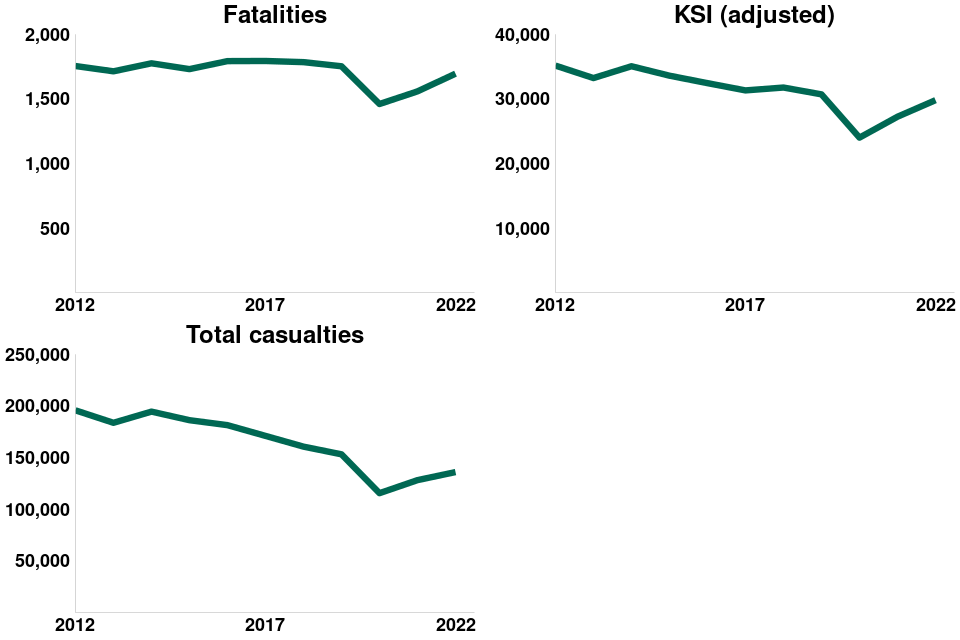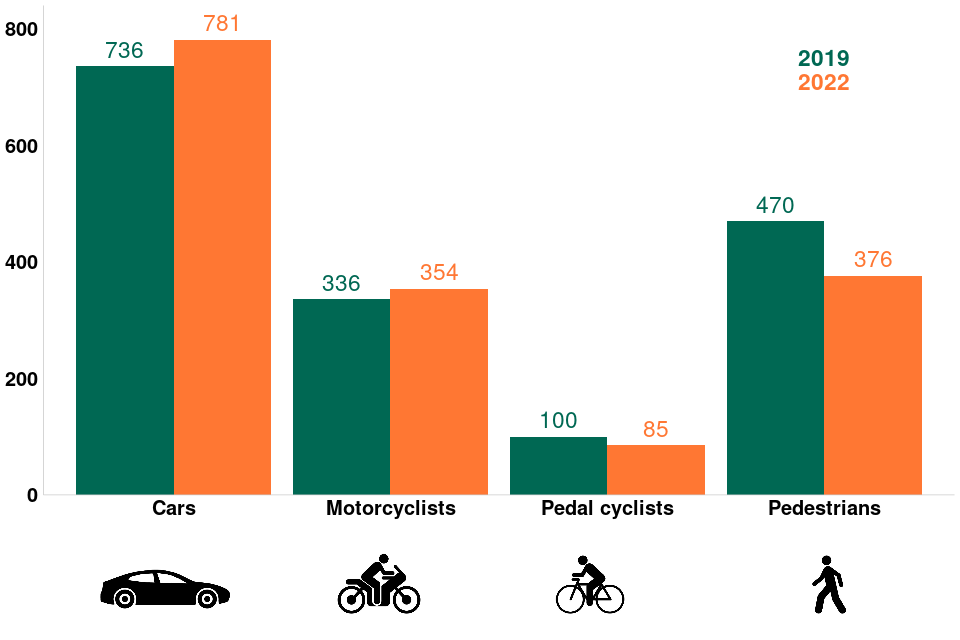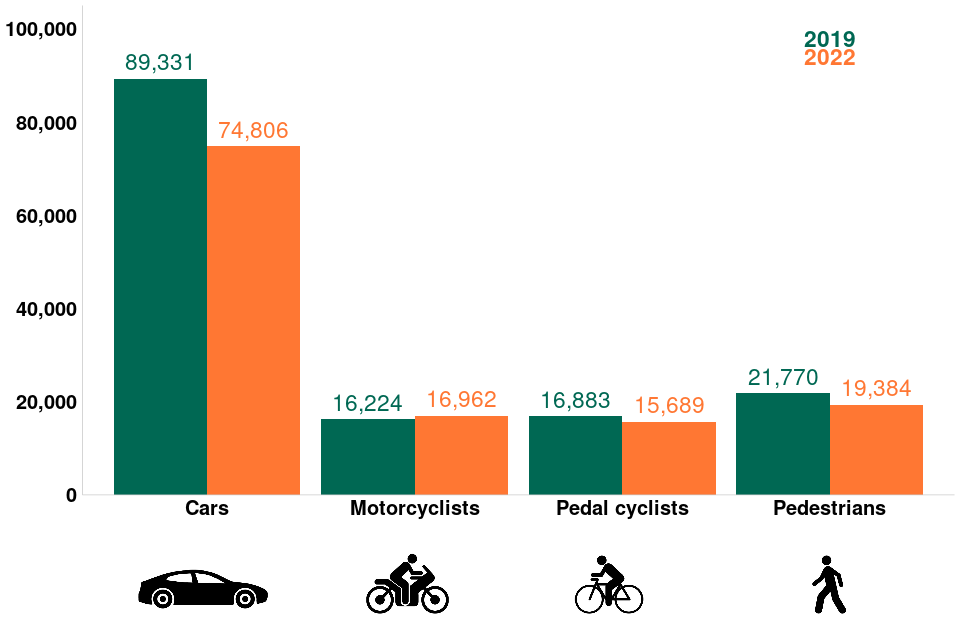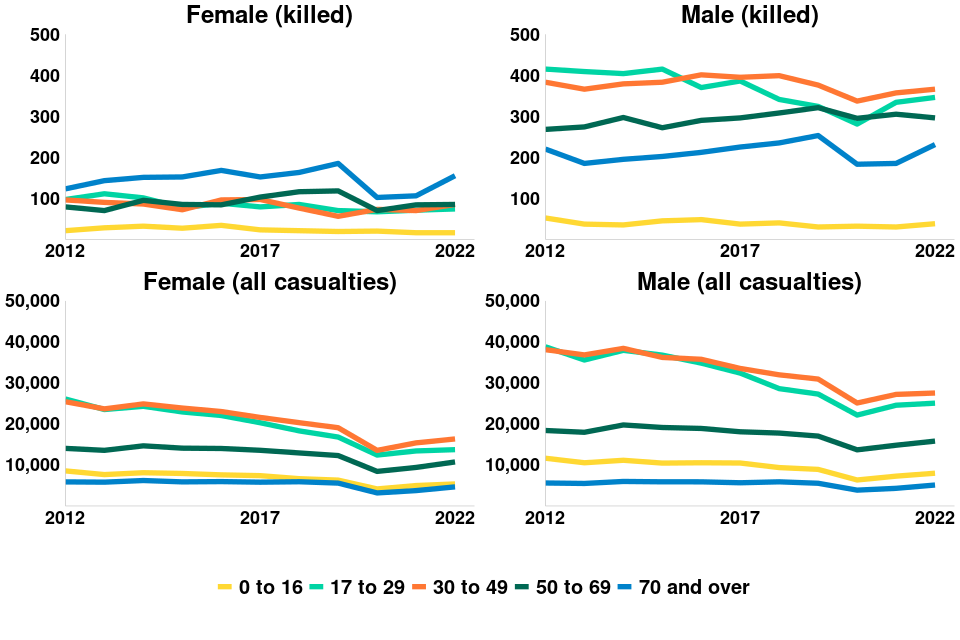Reported road casualties Great Britain, provisional results: 2022
Published 24 May 2023
About this release
This release provides an estimate of the number of personal injury road traffic casualties in Great Britain that were reported by the police in 2022 using the STATS19 reporting system. These figures are provisional as they will change following the end of year validation process.
Data by road user type and police force are available in the accompanying data tables.
Impact of coronavirus (COVID-19)
Recent trends in reported road casualties have begun to normalise after the national restrictions implemented from March 2020 onwards following the coronavirus (COVID-19) pandemic, including periods of lockdown during 2021. Although there were no lockdowns in 2022, comparisons to periods which included the restrictions are affected. For this reason, this publication compares estimates for 2022 with those for 2019, which is the most recent equivalent pre-pandemic year.
More details about the coronavirus restrictions can be found in Coronavirus: a history of English lockdown laws (England only).
Headline figures
In reported road collisions in Great Britain in 2022 there were an estimated:
-
1,695 fatalities, a decline of 3% compared to 2019
-
29,795 killed or seriously injured (KSI) casualties, a decline of 3% compared to 2019
-
136,002 casualties of all severities, a decline of 11% compared to 2019
Considering the different road user types and demographics, the statistics show:
-
the road user type with the biggest estimated percentage change for 2022 compared to 2019 for fatalities was pedestrians, which showed a decline of 20%
-
of the 4 main road user types, car occupants had the biggest estimated percentage change for 2022 compared to 2019 for all casualties, which showed a decline of 16%
-
in 2022, 75% of fatalities and 62% of casualties of all severities were male
Chart 1: Reported road KSI (adjusted) casualties, in Great Britain, 2012 to 2022 (provisional)

Things you need to know
Provisional figures
Figures in this release are provisional and are based on data supplied by police forces by May 2023. A small amount of missing data has been estimated. Figures will change following updates from the police and the end of year validation process. Further details are given in the background information section.
Traffic figures and casualty rates
Road traffic figures for 2022 were not available for this release, so casualty rates have not been produced. Casualty rates will be available as part of the final annual road casualty statistics in September 2023.
Severity adjustment
The figures in this release for injured casualties are based on adjusting figures reported by the police to take account of changes in the reporting of injury severity by some police forces in recent years. These adjusted figures can reliably be used to compare trends over time across the country. More details can be found in our severity adjustments guidance.
Data coverage
There is no obligation for people to report all personal injury collisions to the police. These figures, therefore, do not represent the full range of all collisions or casualties in Great Britain. All collisions reported by the police and that occurred on a public highway involving at least one motor vehicle, horse rider or pedal cyclist, and where at least one person was injured, are included in these statistics. More information on STATS19, how road traffic casualty data is collected and how these figures are produced can be found in the accompanying guidance.
Overall casualties
Casualties by severity
Casualties are broken down into fatalities (people killed in road collisions), and those injured (further split into seriously and slightly injured based on type of injury sustained). Killed and seriously injured casualties are commonly grouped together as ‘KSIs’.
It has long been known that non-fatal (and particularly slight) casualties are under-reported to the police, though we believe that the trends shown are likely to reflect genuine changes. Further information is available in the quality section below.
Chart 2 shows the trend in road casualties by severity over the last decade. Trends in road casualties are affected by a wide range of factors, with 2020 and 2021 being impacted by COVID-19. There is an increase in casualty numbers between 2021 and 2022, this is due to the impact of national restrictions on 2021 casualty numbers. In the decade prior to the pandemic in 2020, fatalities had been broadly stable. 2022 broadly shows a return to pre-pandemic trends.
In reported road collisions in Great Britain in 2022 there were an estimated:
-
1,695 fatalities, a decline of 3% compared to 2019
-
29,795 KSI casualties, a decline of 3% compared to 2019
-
136,002 casualties of all severities, a decline of 11% compared to 2019
Chart 2: Reported road casualties by severity, in Great Britain, 2012 to 2022 (provisional) RAS9101

Table 1: Reported road casualties by severity, in Great Britain, 2022 (provisional) compared with 2019 and 2012 RAS9101
| Severity | 2022 | % change from 2019 | % change from 2012 |
|---|---|---|---|
| Killed | 1,695 | -3 | -3 |
| Seriously injured (adjusted) | 28,101 | -3 | -16 |
| KSI (adjusted) | 29,795 | -3 | -15 |
| Slightly injured (adjusted) | 106,206 | -13 | -34 |
| All casualties | 136,002 | -11 | -31 |
Casualties by road user type
The 4 main road user types (car occupants, pedestrians, motorcyclists and pedal cyclists) are used in the charts below to show comparisons with 2019.
While provisional statistics for the 4 main road user types are likely to give a reasonable indication of trends, figures for other road user types can be impacted by classification issues, as explained in the quality section below. Therefore, these figures should be interpreted with caution.
‘Other vehicle occupants’ include e-scooters, which account for much of the increase in casualties for this road user category compared to 2019 figures. A provisional annual update on e-scooter casualties for 2022, which are not explicitly covered in this release, is available in the e-scooter factsheet.
Fatalities by road user type
Chart 3 shows fatalities for 2022 for the 4 main road user types: car occupants, pedestrians, motorcyclists and pedal cyclists.
In 2022, 46% of fatalities were car occupants, 22% were pedestrians, 21% were motorcyclists and 5% were pedal cyclists.
Of these 4 road user types:
-
the biggest percentage change compared to 2019 was for pedestrians, which showed a decline of 20%
-
pedal cyclists also saw a large change compared to 2019 with a decline of 15%
-
motorcyclists and car occupants saw small increases compared to 2019
Chart 3: Reported road fatalities by road user type, Great Britain in 2022 (provisional) compared with 2019 RAS9101

Table 2: Reported road fatalities by road user type, in Great Britain, 2022 (provisional) compared with 2019 and 2012 RAS9101
| Road User Type | 2022 | % change from 2019 | % change from 2012 |
|---|---|---|---|
| Car occupants | 781 | 6 | -2 |
| Pedestrians | 376 | -20 | -11 |
| Motorcyclists | 354 | 5 | 8 |
| Pedal cyclists | 85 | -15 | -28 |
| Goods vehicles occupants | 64 | -3 | 4 |
| Other vehicle occupants | 30 | 1 | 117 |
| Bus or coach occupants | 4 | -71 | -64 |
All casualties by road user type
Chart 4 shows overall casualties figures split into the 4 main road user types: car occupants, pedestrians, motorcyclists and pedal cyclists.
In 2022, 55% of casualties were car occupants, 14% were pedestrians, 12% were motorcyclists and 12% were pedal cyclists.
Of these 4 road user types:
-
the biggest percentage change compared to 2019 was for car occupants, which showed a decline of 16%
-
there was also a decrease for pedestrian and pedal cyclist casualties, but motorcyclist casualty numbers slightly increased compared to 2019
Chart 4: Reported road casualties by road user type, Great Britain, 2022 (provisional) compared with 2019 RAS9101

Table 3: Reported road casualties by road user type, Great Britain, 2022 (provisional) compared with 2019 and 2012 RAS9101
| Road User Type | 2022 | % change from 2019 | % change from 2012 |
|---|---|---|---|
| Car occupants | 74,806 | -16 | -38 |
| Pedestrians | 19,384 | -11 | -23 |
| Motorcyclists | 16,962 | 5 | -12 |
| Pedal cyclists | 15,689 | -7 | -18 |
| Goods vehicles occupants | 4,735 | -5 | -19 |
| Other vehicle occupants | 2,277 | 159 | 77 |
| Bus or coach occupants | 2,147 | -30 | -59 |
Casualties by age and sex
Chart 5 shows fatalities and all casualties split by both sex and age group.
Overall, in 2022:
- 75% of fatalities and 62% of casualties of all severities were male
- 3% of fatalities and 10% of casualties were aged 16 years old and under
- 25% of fatalities and 29% of casualties were aged 17 to 29 years old
- 23% of fatalities and 7% of casualties were aged 70 years old and over
Chart 5: Reported road fatalities and all casualties by age group and sex in Great Britain, 2012 to 2022 (provisional) RAS9102

Fatalities by age and sex
Overall, 75% of fatalities were male in 2022.
In 2022 the age group with the most male fatalities was 30 to 49 year olds with 366 fatalities, a decline of 3% compared to 2019. For females the age group with the most fatalities in 2022 was 70 year olds and over with 155 fatalities, a decline of 16% compared to 2019.
The largest reductions are seen in females in the older age groups when comparing to 2019, however when comparing to 2012 these age groups have seen an increase.
As the numbers in each group are small, there can be large fluctuations when comparing between years.
Table 4: Reported road fatalities by age group and sex in Great Britain, 2022 (provisional) compared with 2019 and 2012 RAS9102
| Sex | Age group (years) | 2022 | % change from 2019 | % change from 2012 |
|---|---|---|---|---|
| Male | 0 to 16 | 38 | 27 | -27 |
| Male | 17 to 29 | 346 | 7 | -17 |
| Male | 30 to 49 | 366 | -3 | -4 |
| Male | 50 to 69 | 296 | -8 | 10 |
| Male | 70 and over | 231 | -9 | 5 |
| Male | All ages | 1,277 | -2 | -5 |
| Female | 0 to 16 | 16 | -16 | -24 |
| Female | 17 to 29 | 74 | 6 | -24 |
| Female | 30 to 49 | 85 | 52 | -11 |
| Female | 50 to 69 | 85 | -28 | 8 |
| Female | 70 and over | 155 | -16 | 26 |
| Female | All ages | 415 | -7 | 0 |
All casualties by age and sex
Overall, 62% of casualties of all severities were male in 2022.
In 2022 the age group with the most male casualties of all severities was 30 to 49 year olds with 27,539 casualties. For females the 30 to 49 year old age group also had the most casualties of all severities in 2022 with 16,341 casualties.
Compared to 2019 there was a larger fall in female casualties than male casualties, this was broadly similar across all age groups.
Table 5: Reported road casualties by age group and sex in Great Britain, 2022 (provisional) compared with 2019 and 2012 RAS9102
| Sex | Age group (years) | 2022 | % change from 2019 | % change from 2012 |
|---|---|---|---|---|
| Male | 0 to 16 | 7,987 | -10 | -31 |
| Male | 17 to 29 | 25,068 | -8 | -35 |
| Male | 30 to 49 | 27,539 | -11 | -28 |
| Male | 50 to 69 | 15,818 | -7 | -14 |
| Male | 70 and over | 5,106 | -8 | -9 |
| Male | All ages | 81,518 | -9 | -28 |
| Female | 0 to 16 | 5,370 | -15 | -37 |
| Female | 17 to 29 | 13,735 | -18 | -47 |
| Female | 30 to 49 | 16,341 | -14 | -36 |
| Female | 50 to 69 | 10,733 | -13 | -24 |
| Female | 70 and over | 4,654 | -16 | -21 |
| Female | All ages | 50,833 | -15 | -36 |
Background quality information
Detailed guidance on road casualty statistics is given on our guidance page. A full list of the definitions used in this publication can be found in our notes and definitions documentation.
Quality and methodology
Quality
Road casualty statistics have been assessed as National Statistics, indicating compliance with the Code of Practice for Statistics. Full details of the quality of these statistics are available in the background quality report.
There are several important areas which users of the statistics should be aware of which are listed below.
Provisional figures
These provisional annual figures are the second national statistics published on the number of road casualties in Great Britain during 2022. They follow the mid-year estimates published in November 2022. Final annual figures are scheduled for publication in September 2023.
These are provisional estimates which have not been validated in detail and include imputation for missing data. Missing data for Staffordshire and Wiltshire police forces has been imputed for some months where data was not supplied or not considered to be complete. Overall the imputed data accounts for 1.45% of casualties and 1.52% of fatalities. There may be some duplicates, as some casualties might have been logged twice or more, these will be deleted following end of year validation. The potential of duplicate records is relatively small and therefore this publication provides a good picture of the road safety landscape especially at high aggregation.
Provisional results for some road user types can be impacted by misclassified vehicle types. Misclassified vehicle types are reported back to the police who will return a designated vehicle type where notified. Vehicles are matched to the Driver and Vehicle Licensing Agency database and where there is a good body type match, vehicle type may be reclassified.
These factors are unlikely to affect the high-level national trends shown, but will have a bigger impact on figures for individual police force areas.
Under-reporting
Comparisons of road collision reports with death registrations show that very few, if any, road collision fatalities are not reported to the police. However, a considerable proportion of non-fatal casualties are not known to the police, as hospital, survey and compensation claims data all indicate a higher number of casualties than those recorded in police collision data. More information on the coherence of the police reported data with alternative sources can be found in our comparison to other sources of information on road casualties.
Changes in reporting systems used by police forces
From 2016 onwards, figures on the severity of injury have been affected by a large number of police forces changing their reporting systems. It is likely that the recording of injury severity is more accurate for forces using these new reporting systems.
The Office for National Statistics (ONS) Methodology Advisory Service have completed analysis to quantify the effect of the introduction of new injury based reporting systems on the number of slight and serious injuries reported to the police, and to estimate the level of slight and serious injuries as if all police forces were using injury-based reporting systems.
For more information, please see our guide to severity adjustments.
Online self-reporting
Online self-reporting is part of a wider project for digital public contact known as Single Online Home. It is funded by the Home Office to allow people involved in road traffic collisions to report the collision to the police online should they choose to do so, rather than having to physically report it at a police station.
The principle of online reporting is to make it easier for members of the public to report collisions. It is expected that the introduction of online reporting will affect the number of non-fatal (and particularly slight) casualties reported and therefore impact the total for Great Britain, as the public will have more reporting options available to them.
See our analysis of the impact of online self reporting for more details.
User engagement, developments and STATS19 review
Details of users and uses of road casualty statistics and response to recent user feedback is available from our user engagement page.
The STATS19 system which provides the majority of statistics for this publication is periodically reviewed to keep up with changes in technology, to make improvements to completeness and accuracy, and to reduce the reporting burden. Key recommendations of the latest review, carried out in 2018, can be found in the full STATS19 review report.
National Statistics and pre-release access
These statistics were designated as National Statistics in July 2009. The continued designation was confirmed in July 2013. National Statistics are produced to high professional standards set out in the Code of Practice for Statistics. They undergo regular quality assurance reviews to ensure they meet customer needs. More information can be found on our national statistics status webpage.
Details of Ministers and officials who receive pre-release access to these statistics up to 24 hours before release can be found in our pre-release access list.
Instructions for printing and saving
Depending on which browser you use and the type of device you use (such as a mobile or laptop) these instructions may vary.
Tablets and mobile devices normally have the option to “find in text” and “print or save” in their sharing or quick options menu of their browser, but this will vary by device model.
How to search
Select Ctrl and F on a Windows laptop or Command and F on a Mac
This will open a search box in the top right-hand corner of the page. Type the word you are looking for in the search bar and press enter.
Your browser will highlight the word, usually in yellow, wherever it appears on the page. Press enter to move to the next place it appears.
Contact details
Road safety statistics
Email roadacc.stats@dft.gov.uk
